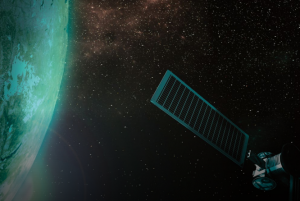This article was originally published in the June 2018 issue of SIMULIA Community News magazine and is the first part of a two-part article about how Airbus Defence and Space designs 3D-printed satellite-antenna components with the help of SIMULIA’s CST STUDIO SUITE software. Stay tuned for the second part of this article where we discuss the production and performance advantages.

There’s a lot of noise going on out there in space as men and machines send electronic messages back and forth across the void. To enable everyone to hear each other better, radio-frequency (RF) waveguide filters have been key technologies for communications since the earliest days of the Space Age.
Although the sky is crammed with radio signals, these filters serve as gatekeepers that screen out unwanted frequencies while allowing selected channels to pass through. A typical modern telecommunications satellite can carry hundreds of such filters. These are designed with complex internal contours specifically chosen to work with very distinct frequencies that allow for multiple signal beams.
Airbus Defence and Space Ltd. has worked on a variety of projects with the European Space Agency (ESA) for decades; the Space Systems division of Airbus supports ESA with satellite-antenna design. Lately, building on previous research and the increasing potential of additive manufacturing to revolutionize design thought, Airbus Defence and Space has been developing 3D-printed RF filters for ESA with the help of SIMULIA CST STUDIO SUITE software.
Heading the design team for the latest ESA project, Airbus RF Engineer Paul Booth studied electrical and electronic engineering at Leeds University. A specialist in waveguide and coaxial filters, Booth read a Request for Proposal (RFP) from ESA that piqued his interest.
AN OPPORTUNITY TO APPLY 3D PRINTING THOUGHT TO A CONVENTIONAL DESIGN
“We’d already done some other work on 3D printing with ESA and this seemed the perfect opportunity to extend this to waveguide filters,” he says. “At the start of the previous project ESA were in the early stages of considering additive manufacturing for mechanical components and we suggested using metal as the material for 3D printing of RF components in a multi-beam feed array.”
A team was formed with Airbus Innovation Works, and Space Engineering, who would provide manufacturing know-how and design support, respectively. “We won the contract and then tried to think a little out of the box with 3D printing, rather than relying on tried-and-tested standard realizations and just putting rounded corners onto the filters to improve RF performance,” says Booth.
At present, communication between satellites and Earth is almost exclusively RF-based, with improving performance an ongoing goal. “There are some experiments using lasers but these are mainly restricted to inter-satellite communications at the moment,” Booth says. “So for most current filters you still need a directional antenna for the up and downlinks. The payloads tend to be ‘bent-pipe’ so that the satellite receives a signal at one frequency and transmits it back to earth downconverted in frequency. This is beginning to change though as operators seek more flexibility.”
For the ESA project, Booth’s team recommended aluminum for its low density and good thermal conductivity, which is important for high-power filters to allow the heat to be effectively diffused away. It is also a full melt process which decreases porosity, essential if the component requires silver plating.
“Our experience with the technology certainly helped us to secure the waveguide filter contract,” says Booth. “It was during this project that we realized that some of the challenges of 3D printing could be overcome with a bit of thought to create a better overall product.”
